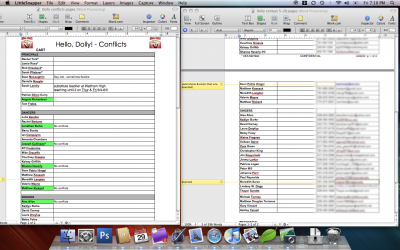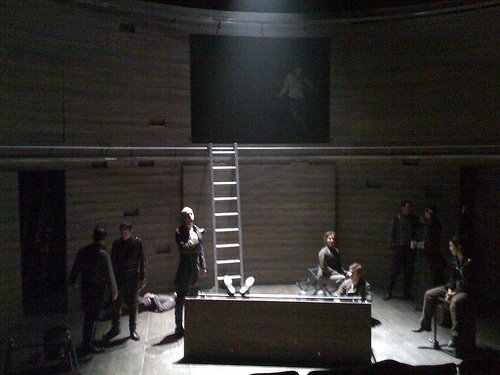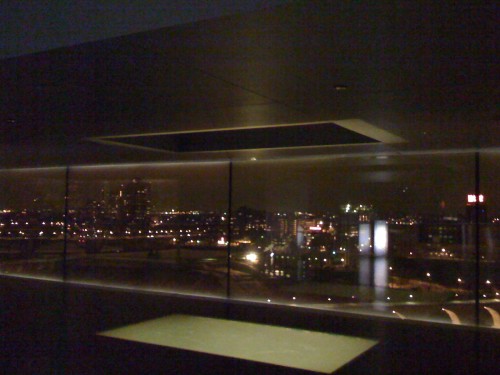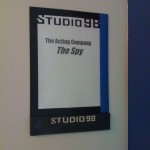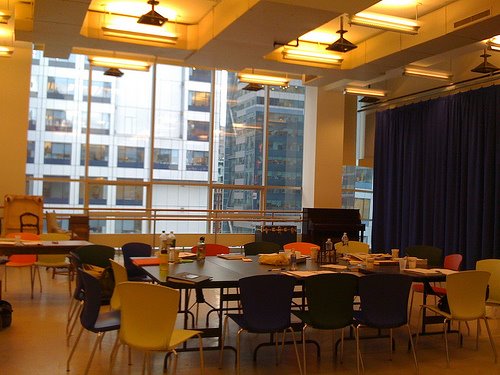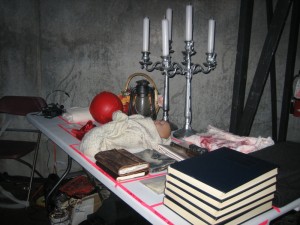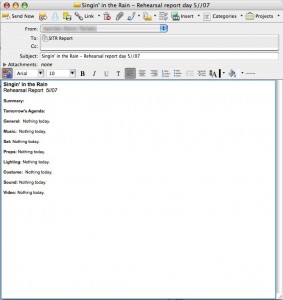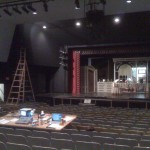 We close Dolly tomorrow, and I’m definitely going to miss it. The show has been a pleasure from start to finish. Our houses have been packed, and the response from the audience wildly enthusiastic. There are so many numbers that stop the show — “Sunday Clothes,” “Hello, Dolly” and “Before the Parade Passes By” tend to be the ones where the actors often get stuck standing there waiting for people to stop clapping for 30 seconds or more. It’s really fun to work on a good show, especially one that has such iconic moments as those three songs. The set is still unwieldy at times (it’s the most inconveniently overbuilt, bent-out-of-shape pile of steel and wood you could ever work with), but it looks great, and a lot of the light cues are really cool and fun to play with. For calling a show, it’s pretty high up there on satisfying experiences. Not so hard as to be frustrating, but it’s challenging to keep up to the level of all the other excellence on the stage.
We close Dolly tomorrow, and I’m definitely going to miss it. The show has been a pleasure from start to finish. Our houses have been packed, and the response from the audience wildly enthusiastic. There are so many numbers that stop the show — “Sunday Clothes,” “Hello, Dolly” and “Before the Parade Passes By” tend to be the ones where the actors often get stuck standing there waiting for people to stop clapping for 30 seconds or more. It’s really fun to work on a good show, especially one that has such iconic moments as those three songs. The set is still unwieldy at times (it’s the most inconveniently overbuilt, bent-out-of-shape pile of steel and wood you could ever work with), but it looks great, and a lot of the light cues are really cool and fun to play with. For calling a show, it’s pretty high up there on satisfying experiences. Not so hard as to be frustrating, but it’s challenging to keep up to the level of all the other excellence on the stage.
Today I spent pretty much all my waking hours working on paperwork for Mame, and while I was at it, decided to do the paperwork for La Cage at the same time since they start off the same templates. All the Mame stuff got done, and except for the contact sheet which is half-done, La Cage is as good as it can get until we get closer. It took me six hours, right up until the time I had to leave for the theatre, but I eliminated a few hours of work for myself over the weekend — and over the weekend four weeks from now, when I’d need to do all that La Cage stuff. I’d have kept going too, if I didn’t have to go to the show!
Tomorrow I’ll probably spend some time taking notes on the Mame script, but I’m pretty well caught up until we have a schedule. We have a production meeting on the dinner break of the first rehearsal (I hate doing that, but we had to to accommodate people’s schedules). We’re building the set for this one, which is a big undertaking but also good because we don’t wind up with set pieces that are too tall for the theatre, which happens, oh, every time we use a rental set. A lot of it was built during this past week and is shoved in random corners of the building, like in the dance studio, until Dolly starts loading out tomorrow. The truck will arrive in the afternoon, and all pieces not used in the show will be loaded then. The rest of course will have to wait until they’re done on stage!


